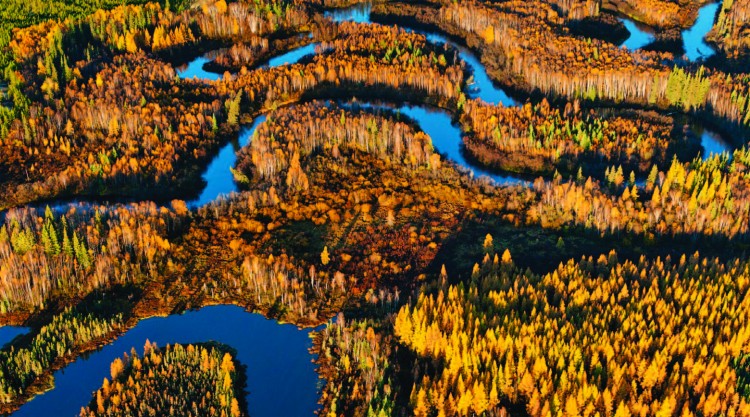NEW YORK—Ten years after 9/11, what exactly does our world look like? Materialistic greed in conjunction with the desire for convenience is still readily strong in the minds of the many. But how does one effectively display an image like that? It sometimes takes the negative consequences of our actions to be displayed in full view before one realizes the folly of our ways.
Photographer Garth Lenz has successfully documented the consequences of our actions when taking into consideration 9/11’s influence on America’s desire to obtain oil from a non-Middle Eastern source and thus search in Alberta’s Tar Sands for oil.
Alberta’s Tar Sands are located in Alberta, which is in western Canada and borders Montana in America. According to Cambridge Energy Research Associates, a leading advisor to international energy companies and governments, Canada, which has the world’s second largest oil supply, will supply more than one-third of America’s oil by the year 2030.
The Calgary firm TransCanada Corp. desires to build a pipeline called Keystone XL from Edmonton Hardisty in Alberta to Texas in the United States. There is already a pipeline called Keystone, which runs from Edmonton Hardisty to Patoka, Ill., and Cushing, Okla.
Many locations along the route that Keystone XL is supposed to carry the controversial oil, however, are completely against the idea, especially after the tragic BP oil spill of 2010.
Though the project alone is estimated to bring over $20 billion into America, including job growth, the two ways of extracting the bitumen, some say, will inevitably damage and eventually destroy the natural environment upon which all depends.
So in a sense, we would risk endangering our lives or those of our descendants in exchange for the immediate gratification of convenience. This is what Lenz exposes through his striking use of photography.
Juxtaposing beautiful images of the neighboring Peace-Athabasca Delta against the dead, barren, ghost-like images of the Alberta Tar Sands makes a sound statement. The contrasting elements possessed by the images take one aback and make one think things anew.
“Boreal Forest and Wetland” is an image of bright colorful vegetation and abundant life. “Confluence of Carcajou River and Mackenzie River” is another image of a beautiful landscape. The flowing river frames and lines the rich green of the surrounding vegetation.
The colorful and almost otherworldly image entitled “Rouge Mountains” depicts the world’s third largest water basin, which is located within the Mackenzie Valley.
In stark contrast, the image titled “Tar Pit 3” depicts a landscape that looks like pieces of old brown gum that have been strewn to crisscross the black sole of an old, worn, and dirty shoe. “Tar Sands Upgrader in Winter” depicts a scene that is reminiscent of a storm troopers’ compound; the storm troopers were not the good guys.
Then there is “Tailings Pond Abstract 2,” which depicts an aerial view spanning the extent of the damage caused by the Alberta Tar Sands. The water gives off the oily rainbow effect that we sometimes see when the sun reflects off of the oil left on the ground after a used car putts away.
Lenz describes the Tar Sands in a blog: “From the ground you feel like you are in some frozen gulag forced labour camp, or some dead planet from a science fiction movie where convicts are forced to labour. Of course, neither of these comparisons is really much of a stretch.”
PowerHouse Arena has worked alongside SocialDocumentary.net to exhibit Lenz’s images from his work titled “Canada’s Tar Sands and the True Cost of Oil,” which won the first prize in the Ten Years After 9/11: Searching for a 21st Century Landscape call. The exhibit is being held at powerHouse Arena until Sept. 16.
PowerHouse Arena is located at 37 Main Street in DUMBO (Down Under the Manhattan Bridge Overpass), Brooklyn. Opening reception will be held on Saturday, Sept. 10, from 7 p.m. to 9 p.m.
Lenz and the other winners who are featured in the exhibition—Michael Robinson Chávez with Metamorphosis: Images from the Arab World, Florian Büttner with Modern Slaves of Dubai, and Michael Busse with work from Unidentified Landscapes—are all expected to be in attendance.
PowerHouse Arena was launched by powerHouse Books in 2006 to help further and enhance the creative thought process. A strong advocate of the arts and of urban and world culture, powerHouse Arena is like a small New York in which many different types of art, books, events, and exhibitions congregate into a melting pot of flavorful information.
We have become a society that sometimes mistakes what is good with what is materially abundant. Many of us, focused on our own pursuits, rarely take into consideration the bigger picture.
If we reconsider our approach to this shared environment we call Earth, we can possibly substantiate a better future for mankind. Lenz’s works make us understand that it is very difficult to sincerely find something wrong with respecting nature, while it is very easy to find something wrong with abusing it.







Friends Read Free